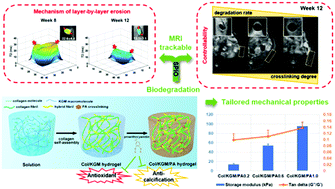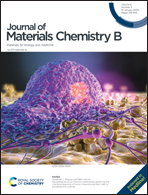Proanthocyanidin-crosslinked collagen/konjac glucomannan hydrogel with improved mechanical properties and MRI trackable biodegradation for potential tissue engineering scaffolds†
Abstract
Collagen (Col) has been intensively exploited as a biomaterial for its excellent biocompatibility, biodegradation and bioactivity. However, the poor mechanical properties and rapid biodegradation of reconstituted collagen hydrogels have always been the bottlenecks for their further development especially for vascular tissue engineering. Herein, based on the self-assembly characteristics of collagen, a ternary hydrogel scaffold, comprising rigid collagen molecules, flexible konjac glucomannan (KGM) chains and biocompatible crosslinkers of proanthocyanidin (PA), has been designed to achieve a synergistic interaction for essentially optimizing the mechanical properties of the so-obtained Col/KGM/PA hydrogel, which possesses not only substantially improved strength but also good elasticity. PA endows these scaffolds with controllable biodegradation and anti-calcification and antioxidant activities. TEM discovered the co-existence of two types of fibrils with distinctly different arrangement patterns, explaining the contribution of KGM macromolecules to elasticity generation. The in vivo variations of Col/KGM/PA implants are visualized in real-time by magnetic resonance imaging (MRI). Moreover, a quantitative technique of MRI T2-mapping combined with histology is designed to visualize the in vivo biodegradation mechanism of layer-by-layer erosion for these hydrogels. Simultaneously, three different relationships between the respective processes of in vivo degradation and in vivo dehydration of these controlled hydrogel implants were clearly revealed by this technique. Such a designed Col/KGM/PA composite hydrogel realizes the essential integration of good biocompatibility, controllable biodegradation and improved mechanical properties for developing a desired scaffold material for tissue engineering applications.



 Please wait while we load your content...
Please wait while we load your content...